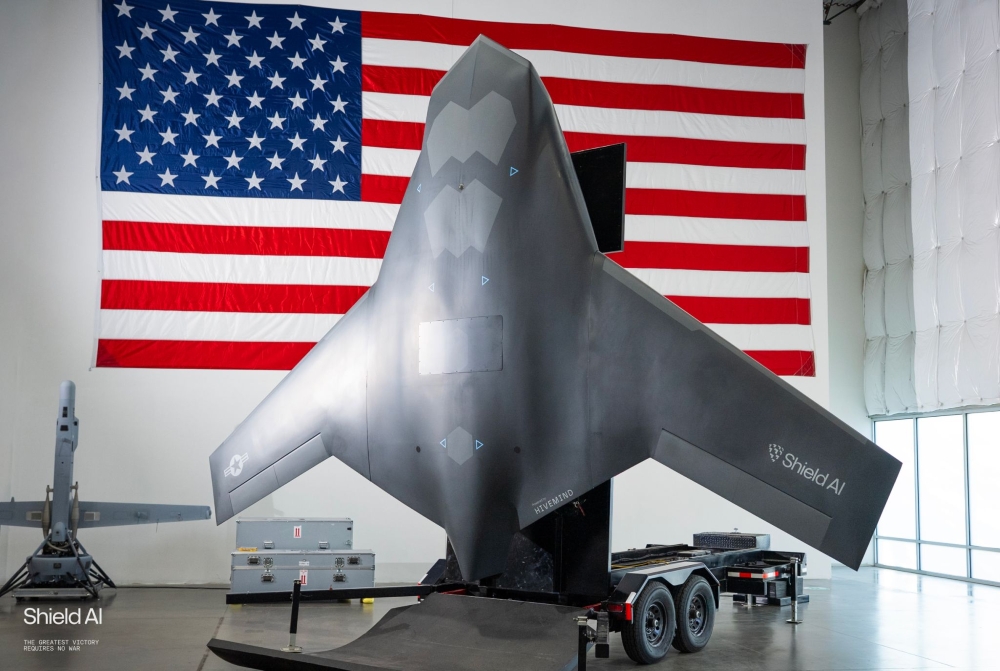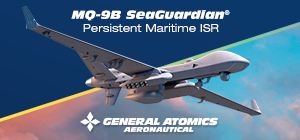
Shield AI is already known for a Vertical Take Off and Landing drone, the V-BAT, but the scale and complexity of the new product they have just unveiled is a world apart. The X-BAT is a large scale, stealth, fully VTOL Collaborative Combat Aircraft which promises to bring very high performances in a “runway independent” package.
Shield AI says the X-BAT will have a “maximum range” of 2.000 nautical miles, with a fighter jet-like ceiling of 50.000 feet. The company specifies the 2.000 miles range include a load of weapons, it is not a mere ferry range figure. This translates to a theoretical strike range of around 1.000 miles.
At 26 feet of length (circa 8 meters) with a wingspan of 39 (11.8 meters), the drone will have considerable dimensions, considerably larger than the Increment 1 CCAs selected by the USAF.
In Shield AI’s vision, the X-BAT must deliver “5th gen capabilitities” in a way that does not depend from vulnerable runways and that costs “a tenth” of a crewed F-35.
To achieve full VTOL performance, the X-BAT is launched and recovered vertically from a trailer-mounted ramp. The thrust required is not obtained through additional lift elements as happens on the F-35 (the lift fan), and the tail-sitting launch and recovery formula is intended to deny the need for complex podded engines or other means of fully vectoring the thrust. The only thing needed is an “exuberant” engine, an F-16 class engine, which in afterburner has enough kick to lift the X-BAT clear off the ground.
The X-BAT will achieve VTOL control and attitude transition by using a degree of thrust vectoring, but through a “simpler” nozzle with 3-dimensional movement, like the ACTIVE [Advanced Control Technology for Integrated Vehicles] tested experimentally in the past on the F-15 and F-16 to increase their maneuverability.
The vertical landing begins with an impressive Cobra maneuver to initiate the semi-vertical descent, and eventually sees the X-BAT engage a mechanism in the trailer to come to a stop. Being lighter having expended (much) of the fuel if not also its mission payload, upon return the jet can land without the use of the afterburner. The complex guidance, highly accurate, required for the landing is being realized leveraging the proven guidance, navigation and control of the V-BAT, even though as we said this is a far smaller, lighter and simpler machine, pushed by a ducted propeller.
X-BAT is a literal case of putting a big engine in a (not so big) aircraft. The excess thrust that comes from using a F-100 or F-110 engine or comparable enables the fuselage to make ample use of metal, simplifying construction and reducing cost as there is no rush to use composites everywhere.
The cranked-kite wing formula is well understood and Shield AI, at least initially, is looking at limiting the use of composites to the outer surfaces to accelerate the time to production start. Over time, composites could be introduced to reduce the empty mass of the aircraft and gradually improve performances.
Shield AI has already carried out extensive test campaigns in the wind tunnel, crucially demonstrating the air inlet performance including in the transitions to and from vertical (up to 90° Angle of Attack), which is not a mean feat.
Shield AI claims the X-BAT is a high-subsonic cruising, true low observable platform that is “much” faster than the first Increment 1 CCAs currently at the start of their flight trials.
The design has 2 internal weapon bays and options for external carry of larger weapons as well, to ensure a fully multi-role platform useful in the whole spectrum of missions, from ISR to Air to Air and Air to Ground. Importantly, Shield AI says the “standalone” system must be capable of both active and passive sensing, which suggests the aircraft will come with not just with the “multi-mode radar” specifically mentioned in the video but, probably, also an IRST fit. An organic EW system is part of the design: the video highlights the wing profile suggesting apertures will be located along them.
In its presentation video, Shield AI shows an Air to Air load comprising a couple of internal AMRAAM and external carry of the much larger AIM-174B GUNSLINGER, the ultra-long range AA derivative of the SM-6. For Air to Ground, the video shows an external load of JASSM with 2 internal JSOW C-1 gliding bombs.
Importantly, the X-BAT will have a powerful, extensive Autonomy core, the HIVEMIND, which already exists and is the core of Shield AI’s activities. It is flying on the V-BAT already and it has also flown on the General Atomics MQ-20 AVENGER MALE in experiments. The AVENGER is GA-ASI’s test bed for future Autonomous Collaborative Platforms and using HIVEMIND it has demonstrated important operational capabilities at the exercise ORANGE FLAG earlier this year, including simulated air combat.
HIVEMIND will make the X-BAT able to carry out its mission with very limited human input. The Human In the Loop will authorize lethal force use where necessary, but much of the X-BAT missions within a pre-determined “box” of sky will be largely automated. Shield AI claims its AI core is extremely advanced, and also notes that X-BAT’s navigation system has been especially conceived to be independent of GPS signal as that cannot be relied upon in a contested environment.
The aircraft, at least in its first generation shape, will probably not be fitted with aerial refuelling receiver capability but space is being reserved to enable the later addition of a probe, to refuel with the Drogue method.
The aircraft can be moved on its trailer-launcher. The wings fold for transport, which also make it very “dense” to pack aboard ships: Shield AI claims up to 60 could be packed inside a LHA of the AMERICA class, for example. On land, the Company claims that launch requires a cleared zone of no more than 100 x 100 feet.
Shield AI plans to announce a number of industrial partnerships in coming months as it builds a team that can ensure both the aircraft and the trailer-launcher can be built in substantial numbers if, as the Company obviously hopes and believes, the X-BAT turns out being a success on the market.
It plans to be able to carry out demonstrator flights in the second half of 2026 that will include the VTOL take off and landing sequences, ahead of flights with a “complete” aircraft in 2028.
Follow us on Telegram, Facebook and X.








.png)
